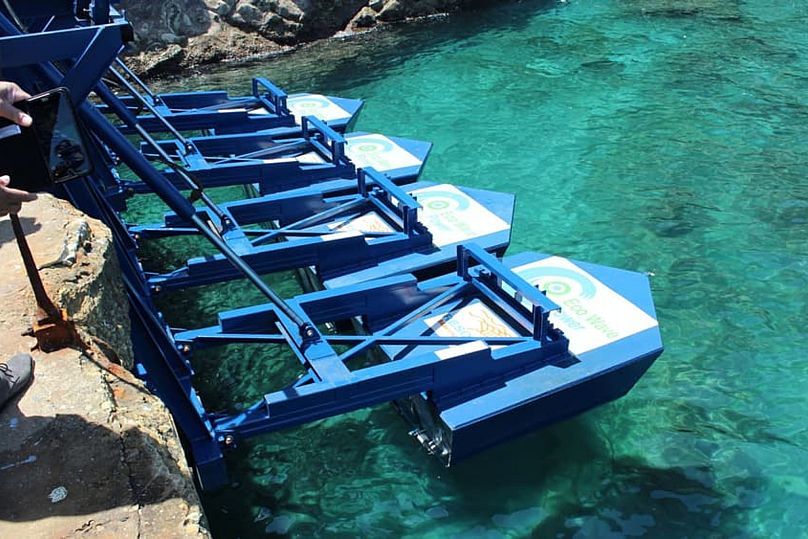Wave energy can produce much more energy than wind power, with much less space, why aren’t we using it more?
According to the United Nations, 60 per cent of global greenhouse gas emissions come directly from the way that we currently produce our electricity.
Wind and solar are increasing in popularity but as global demand rises, innovation is needed to improve clean energy production.
71 per cent of the earth is covered in water yet only around 1.5 per cent of the global energy is produced through wave power.
In the US, it is estimated that 66 per cent of all energy needs could be met using wave power. So why aren’t we doing more?
Euronews Green spoke to Eco Wave Power CEO, Inna Braverman about how she’s taking on the challenge.
Inspired to create simple wave power
Inna isn’t an engineer, a scientist or a billionaire financier. When asked what set her down this path, she talked about her early years as a baby in Ukraine.
Two weeks after she was born in 1986, the Chernobyl nuclear disaster occurred.
“I was one of the babies that got hurt from the negative effects of the explosion. I actually had respiratory arrest and a clinical death,” Inna explains.
Fortunately, her mother was a nurse and was able to resuscitate her.
“So I found myself growing up with the feeling of purpose like I should really change the world because I got a second chance in life.”
Inna’s family emigrated and from the age of four, she grew up in Israel. At first, she thought she’d change the world through politics and chose to study political science at University.
Upon graduating she found it hard to find a job and ended up working as a translator for a renewable energy company. It was here that she became inspired.
“Wind and solar were fields that everybody knew about, it was already packed with competition and there was not too much that you could innovate,” she explains.
“Wave energy was something that all the engineers and the scientists really believed in. Yet no company, no matter how big, no matter their financial resources, human resources, technical expertise, no matter what they had… was able to make it a reality.”
With her mind set on this challenge, Inna began researching.
“I said to myself, 'I don't have the money, nor the technical background and not the contacts, but I can make it happen.'”
How does Eco Wave Power solve wave power’s problems?
Inna describes the key points that have delayed wave energy as ‘the five fear factors’.
“99 per cent of the developers in the wave energy industry have decided to pursue offshore technologies,” she explains.
By choosing to construct power stations offshore, the installation and maintenance costs are huge. And when storms come, the stations are incredibly vulnerable.
Insurers realised that storm damage and total breakdown were a regular occurrence. It became almost impossible to get insurance, and consequently, funding.
With all of these interlinking problems, few had got as far as connecting to the grid. Some started to doubt whether wave power was even possible.
Despite being a renewable energy source, offshore wave power plants also became unpopular with environmentalists as the construction disrupted the seabed and the ecosystems living there.
To combat these issues, Eco Wave Power has brought the power station on land.
The only part of the system in the water is the floaters which bob up and down with the waves. These push hydraulic cylinders which build pressure in accumulators where the energy is stored.
The floaters are attached to existing man-made structures such as piers, breakwaters and jetties.
“We take something that is only used for breaking the waves and is not so good for the environment and we turn it into a source of clean electricity,” Inna explains.
The simplicity of the design makes it cheaper to install and maintain as well as being better protected from inclement weather and therefore, insurable.
With a reliable product developed, Inna then took part in the Unreasonable Impact fellowship in 2020, which provides a support network to scale businesses that are creating solutions to global crises.
What does Eco Wave Power cost to customers?
If you’re wondering how wave power will affect the cost of your electricity bills, Inna suggests that once a commercial plant producing 20 megawatts or more (enough for 20,000 homes) is in place the unit cost significantly reduces.
“Our [average minimum price] of energy decreases to about $0.05 US (€0.05) per kilowatt hour, which is comparable to the prices of onshore wind,” Inna explains.
What’s next for Eco Wave Power?
A pilot station was installed in Gibraltar in 2016. It was the first wave energy system to be connected to the grid in Europe and produced energy there for six years. The 100-kilowatt system produced enough energy for 100 homes.
During this time, Eco Wave Power continually ran tests to update and improve the system.
The pilot station has now been removed and shipped to Los Angeles where it is awaiting installation.
And Gibraltar is currently planning to construct a new marina in an area with optimum waves where they hope to install a larger wave power plant. It could produce around 5 megawatts, or enough for 5,000 homes.
Eco Wave Power has also just connected its first wave power station to Israel’s grid.
Inna hopes to continue to expand across Europe and the USA, adding that ‘the UK is actually one of the most suitable locations in the world for wave energy generation.’
Watch the video above to learn more about Eco Wave Power.












